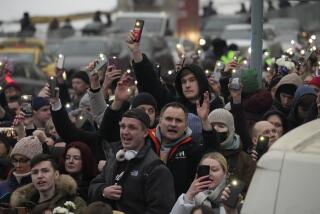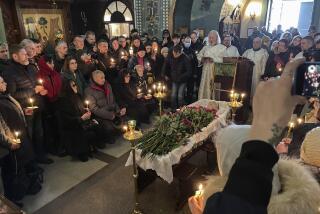We Will Bury You, Vladimir ... Maybe
- Share via
MOSCOW — For more than six decades, glorious military parades and throngs of solemn Soviet citizens passed by the Red Square mausoleum where Vladimir I. Lenin’s mummified corpse lay under glass. Then history passed him by.
Now, as the 15th anniversary of the death of the Soviet Union nears, a debate is brewing about whether it’s time to bury the body of the man who tried to bury capitalism.
The debate isn’t new. What’s different this time is the intriguing hints that Russian President Vladimir V. Putin is agreeable to an interment. He is often accused of taking Russia back to Soviet ways, and removing the founder of the Soviet Union from public display could be a way of deflecting the criticism.
The mausoleum’s aura has been dimming for years. The goose-stepping honor guards are gone. The long lines of devoted pilgrims have given way to small knots of visitors, largely foreign tourists, entering the hushed, austere, dark red stone structure.
In the minute or less before finger-snapping guards usher them out, they see a suit-clad corpse on its back, its goateed face rouged. It’s so well preserved after 81 years under glass that some wonder if it’s a dummy.
At the last military parade in Red Square, a reviewing stand blocked the six-tier mausoleum from sight. That may have been an early warning that authorities were rethinking its presence.
This fall the debate went public, when Georgy Poltavchenko, a prominent aide to Putin, unexpectedly said during a news conference: “Our country has been shaken by strife, but only few were held accountable for that in their lifetime. I don’t think it’s fair that those who initiated that strife remain in the center of our state near the Kremlin.”
Poltavchenko said his opinion was strictly personal. But in the tightly controlled culture of the Kremlin, officials rarely sound off to no purpose. His comments were seen as a way of testing public reaction to an idea that Putin might want to execute.
That belief was reinforced this month, when St. Petersburg Gov. Valentina Matviyenko, also seen as close to Putin, renewed the call.
“We’re not Egyptians,” she said.
Egyptian mummification is, of course, ancient history. In modern times, embalming for permanent public display has been a predominantly communist affair, exalting China’s Mao Tse-tung, Ho Chi Minh of Vietnam, Kim Il Sung of North Korea.
In those countries, burying them simply isn’t up for discussion. But in post-Soviet Russia, the taboo is gone. Yet reactions have been both predictable and surprising.
The Communist Party, still popular among Russia’s poor and elderly, was outraged.
“It defies the nation’s history and common sense,” party leader Gennady A. Zyuganov said. “With their filthy hands and drunken heads they are crawling into the sanctuary of the state.”
The Communists’ ire was stoked further by this month’s pomp-filled reburial of Gen. Anton Denikin, who fought against the Red Army during Russia’s civil war and whom authorities now cast as a patriot.
But Lenin’s ideological enemies have also demurred on the burial issue.
“This matter shouldn’t be stirred up,” Sergei Mitrokhin, deputy head of the pro-business Yabloko party, was quoted in the newspaper Gazeta as saying, “Even if he is buried with all honors ... all the same it will be provocative.”
Putin himself has played to pro-Soviet sentiment with moves such as restoring the Soviet melody to the new Russian anthem.
In 2001, Putin said burying Lenin would suggest that Soviets “had lived in vain.” But he may now want to undermine the Communists and portray them as being in thrall to discredited ideas.
Burial, however, could be risky given growing resentment about the fraying of the Soviet social safety net. In the last year, unprecedented mass demonstrations have broken out against Putin’s move to eliminate many Soviet-era privileges for the elderly and war veterans. This month, millions of public-sector workers struck for a day to protest bare-bones salaries.
Although Putin himself is constitutionally barred from running in the 2008 presidential election, he is widely expected to try to anoint a successor, so his legacy will be very much a campaign issue.
A recent opinion poll by the Levada Center said 40% of the 1,600 Russians surveyed believed Lenin’s body should remain in the mausoleum and 51% thought it should be buried. No margin of error was given. Last year, a survey by VTsIOM found that at least one-quarter of Russians still regard Lenin as having moved Russia forward.
The loyalty of that minority is intense.
“They should leave him in the mausoleum, at least until our generation dies out.... He brought us justice,” declared 75-year-old Valentina Vasilyeva, who was standing near the mausoleum trying to peddle defunct Soviet-era bank notes to tourists.
The ironies are strong. Lenin himself wanted to be buried next to his mother in St. Petersburg. But his successor, Josef Stalin, ordered him put on display, apparently to create a cult that he could harness. Stalin’s body lay next to Lenin’s from his death in 1953 until eight years later, when Premier Nikita S. Khrushchev, on a campaign against the dictator’s murderous legacy, had him buried along the Kremlin wall, where most other Soviet leaders also lie.
Another irony is that although Lenin was a vehement atheist, many supporters of burial use the argument that having a body on display is unfitting for a Christian country.
Russian-born Svetlana Boym, whose book “The Future of Nostalgia” studied communist symbols and post-communist countries’ sense of history, suggested that the calls to inter Lenin are not aimed at burying communism but at stifling discussion of a painful era.
“It’s very curious to me -- not an attempt to deal with the Soviet past, but an attempt to re-Christianize Lenin,” she said.
Whatever one’s ideology, the mausoleum is a tourist draw, as Moscow investment banker Igor Yurgens noted.
“I think it shouldn’t be touched,” he told Gazeta. “It’s a tourist point, as curious an object as the pyramid of Cheops in Egypt.”
More to Read
Sign up for Essential California
The most important California stories and recommendations in your inbox every morning.
You may occasionally receive promotional content from the Los Angeles Times.










